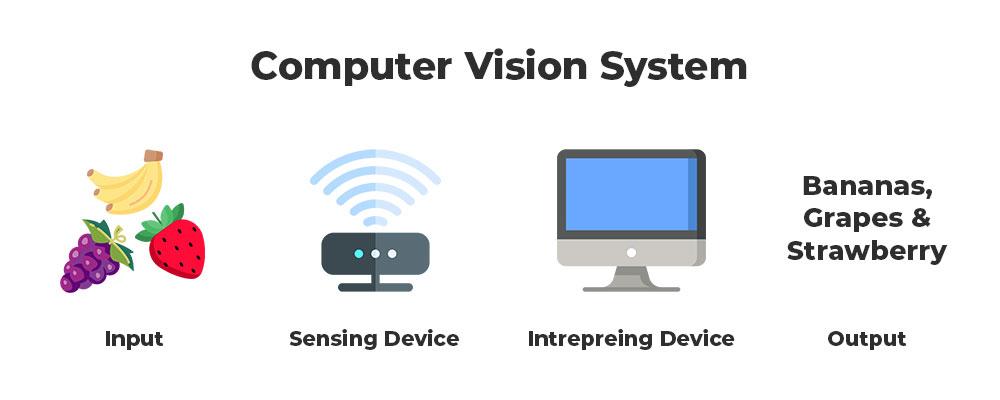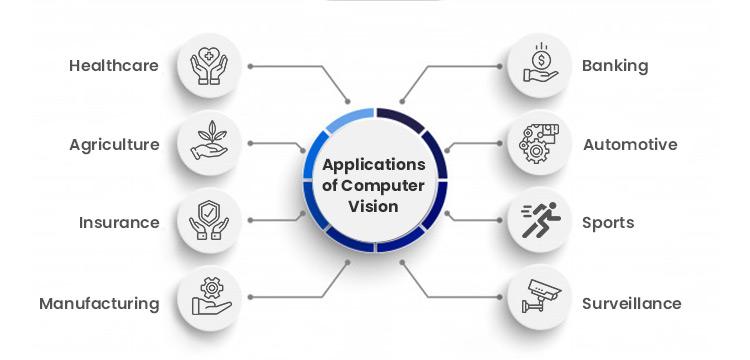Computer vision is one of the most potent and captivating forms of AI, and you’ve probably used it in various ways without even realizing it. Here are some details on what it is, how it functions, and why it’s fantastic (and will only improve). The case studies of CV focus on simulating the complexity of the human visual system so that computers can recognize and analyze objects in pictures and videos, similar to how people do. It was only recently able to function fully. Artificial intelligence has made great strides in recent years and is now capable of outperforming humans in some tasks involving object detection and object labeling. It is due to deep learning, computer vision, neural networks, and artificial intelligence developments.
What is Computer Vision?
One area of artificial intelligence called computer vision teaches and equips machines to comprehend the visual world. Computers can use deep learning models and digital images to identify, categorize, and respond to objects precisely. We produce two point five quintillion bytes of data daily, a staggering amount of data in today’s world. One of the key factors propelling the development of CV has been the growth in data. The first computer vision experiments began in the 1950s, and by the 1970s, it was being used commercially to differentiate between typed and handwritten text. Today, the applications for CV have multiplied exponentially.
You may also like to read about – OpenCV for Python – Its Function & Application
How does Computer Vision Work?

Computer Vision repeatedly analyses the information until it can distinguish between things and recognize images. For instance, a computer must be fed many tire images and tire-related items to be trained to recognize automobile tires. It uses two key technologies: convolutional neural networks and deep learning machine learning (CNN). With the aid of algorithmic models, a computer can learn how to understand the context of visual data through machine learning. The computer will “look” at the information and teach itself to distinguish between different images if enough data is fed through the model. The accuracy rates for object identification have increased along with the development of new hardware and algorithms in computer vision. The accuracy of modern systems has increased from 50% to 95% in less than ten years, making them faster than humans at responding to visual inputs.
Application of Computer Vision

- Machine vision – Businesses have used machine vision to improve operations and quality. To function correctly, machine vision systems require several components, including sensors, cameras, and lighting. Fluorescents, quartz halogen, LEDs, and metal halide, for instance, are popular lighting options for machine vision systems (mercury). For quality control, machine vision systems are frequently employed. For example, harvesting machinery in agriculture is used to locate grapes on a vine so it can pick bunches of grapes without destroying them.
- Transportation – Computer vision is crucial to the automotive industry (ITS) due to its application to intelligent transportation systems. Systems for detecting pedestrians and self-driving cars both rely on computer visuals. Using computer vision, cars can gather information about their surroundings, analyze it, and react accordingly. Autonomous vehicle (AV) driving is made safer, more effective, and more dependable by computer vision.
- Manufacturing – Since the 1950s, manufacturers have been using computer visuals, and more use cases have appeared as technology has advanced. Using computer vision, manufacturing companies can identify defective products, read text and barcodes on products, and help with product assembly—everybody in the supply chain gains when computer vision can assist manufacturers in removing defective products. In general, it has assisted the manufacturing sector in overcoming some of its most frequent obstacles, and the pattern is likely to persist.
- Medical Care – Computer visuals are used in healthcare to facilitate operations and enhance patient care. The following are some significant advantages of using computer vision in a medical setting:
- It improved medical diagnosis.
- They prevent bleeding in pregnant women.
- They are enabling doctors to spend more time with patients at the bedside.
- Recognizing significant issues in CT scans faster than a human can.
Although there are some obstacles to its implementation, Computer vision will become a standard in modern medicine. Finding workable solutions to these problems may take some time for healthcare professionals.
- Construction – Predictive maintenance, maintaining equipment in good working order, and minimizing downtime during significant construction projects can all be helped by computer vision for construction companies and their staff. When there are issues with the equipment, the CV can notify the team so they can fix them before it’s too late. Furthermore, computer vision can offer PPE detection to guarantee worker safety, something the sector strives arduously to achieve.
History of Computer Vision
In the 1950s, early computer vision experiments used some of the earliest neural networks to identify an object’s edges and classify simple things like circles and squares. The first commercial application of computer vision used optical character recognition in the 1970s to translate typed or handwritten text. The blind could now read written text thanks to this development. Facial recognition software grew in popularity as the internet developed in the 1990s, and extensive image collections became accessible online for analysis. These expanding data sets enabled computers to recognize specific individuals in pictures and videos.
Image and Vision Computing
The primary goal of Image and Vision Computing is to provide an effective means of exchange for the outcomes of high-quality theoretical and practical research vital to all aspects of human vision and computer vision. It aims to promote a deeper understanding of the field through a comparison study and performance appraisal of the recommended methodology. Image explanation, scene modeling, machine vision and monitoring, shape analysis, surveillance and tracking active imagination and automated machines systems, SLAM, physiologically CV, motion tracking, stereo vision, pdf file image comprehension, character and offline handwritten recognition, face and action recognition, fingerprint scanners, human eyesight contact, human activity, and behaviour understanding, data transformation from multiple sensor ids, and data aggregation from multiple sensor ids are all included.
Computer Vision Examples
Consider all the possibilities human sight provides, and you can begin to appreciate how many uses there are for computer visuals. Here are a few of the fascinating applications of computer visuals currently being used:
- Autonomous Automobiles – To make self-driving cars possible, computer vision is required. Automakers like Tesla, BMW, Volvo, and Audi use several cameras, lidar, radar, radar, and ultrasonic sensors to gather images from the environment so that their self-driving cars can safely detect objects, lane markings, signs, and traffic signals.
- Google Translate App – To read signs written in a foreign language, you must point your phone’s camera at the words, and the Google Translate app will almost immediately translate them into the language of your choice. It is a handy tool that uses CV, optical character recognition to see the image, and augmented reality to overlay an accurate translation.
- Facial Identification – China is undoubtedly at the forefront of facial recognition technology; many other services use it for police work, payment portals, security checkpoints at airports, and even to dispense toilet paper and deter paper theft at Tiantan Park in Beijing.
Conclusion
We have made some impressive recent progress, but computer vision still needs to be solved. However, numerous healthcare organizations and businesses have already figured out how to use CNN-powered computer vision systems to solve real-world issues. And it’s unlikely that this trend will reverse itself soon. The quantity of data we produce today and use to train and improve CV is one of the key factors influencing its growth. In addition to the enormous amount of visual data (each day, more than 3 billion images are shared online), the computing power needed for data analysis is now available.



This blog is very helpful and great for understanding computer vision and how it works. With the rapid change in the technological world, AI has some really important role that holds the essence to change and transform upcoming technologies. This blog takes you to the surface level of AI technology. This blog will move your knowledge about it from ground level to a complete understanding of computer vision. It works with all the topics that are needed to understand it.
Every aspect has been clearly explained with crisp and informative potioned in different parts according to the matter to understand the topic thoroughly. One should really go for it to have the ideas centered on that topic.
It’s veritably useful and great for understanding computer vision and how it works. With the rapid-fire changes in the technological world, AI is playing a really important part that’s getting the substance to change and transfigure the forthcoming technologies. This blog brings you face to face with AI technology. workshop with all themes that must contain it.
Each aspect was fluently explained with quick and instructional potions in different lanes suitable for a complete understanding of the content. You should really aim to concentrate your ideas on this content. The stylish composition on artificial intelligence and so well organized.
It’s really helpful and great for understanding computer vision and how it works. As a result of the lightning-fast changes in the technological world, AI is playing a really important role in giving future technologies the substance to evolve and modify itself. On this blog, you can engage with AI technologies directly. workshop covering all the required topics.
Each component was thoroughly explained using brief yet informative explanations in a number of methods, allowing for a comprehensive understanding of the subject matter. You should try to concentrate your attention on this knowledge. The sophisticated and carefully thought-out composition on artificial intelligence.
Really appreciate the depth of research that goes into each of these articles. A valuable resource for anyone looking to learn and grow.